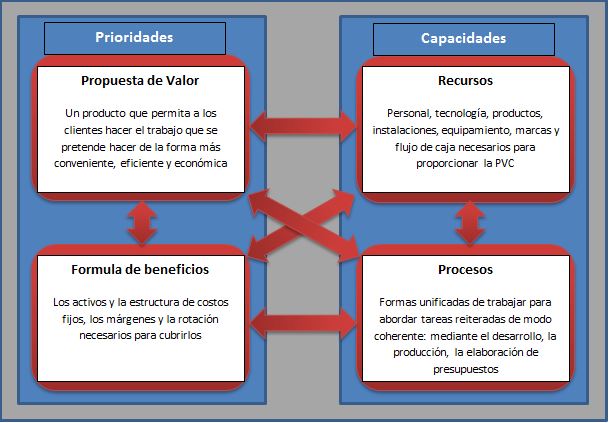These days I have been reading the book by Dr. Clayton Christensen called The Prosperity Paradox, in which he emphasizes that radical innovation oriented to the local market can generate prosperity that will help effectively fight poverty. And how efficiency innovation generates jobs that can be rapidly migrated. The examples he uses, from several developing countries serve to justify his thesis.
But nevertheless; I would like to share my thoughts at this moment in terms of new business models that seek to generate companies to emerge victorious in saturated markets as it happens today. And it is that much of this has to do with the knowledge that Professor Christensen provides through his books.
We will point out some examples to better locate them in the context. There are more than 25 companies among them: Uber ($ 84 MM), Slack ($ 9 MM), Pinterest ($ 13 MM) and Blue Apron ($ 7 MM), which in the last quarter of 2019 have raised their value in the Stock Market . Since all of these companies were funded with venture capital and emerged from Silicon Valley, it could be assumed that the key ingredients that ensured its success were state-of-the-art technologies, digital platforms, and customer bases that were composed primarily of digital natives.
But nevertheless; the secret of their success was that each of them was able to satisfy the clients, and I am referring to a fundamental problem in a certain situation that needed a solution. This means that they manage to generate a disruptive business model for the niche market they were going to impact.
Nowadays every successful company owes its success to its business model. Today many managers and managers are confident that the digital transformation through a digital platform, can offer better alternatives for growth in the market, however; what really drives it and makes it disruptive turns out to be its business model.
In this way, properly executed innovation has the capacity to make companies resistant to changes and form the basis of growth that is not affected by the limits established by traditional businesses.

Harvard University has created a business model framework developed by Professor Clayton Christensen that teaches its students and that consists of 4 categories, namely:
a) A proposal of value for the clients
b) Resources of the organization (such as: human talent, cash flow and technology)
c) The processes necessary to convert the contributions into finished products or services.
d) And finally, the formula of benefits for the company, which dictates the margins, the rotation of assets and the scale required to achieve significant returns.

This way of studying business models is useful, first because it provides a common language and framework for understanding the capabilities of a business. And second, it highlights the interdependencies between the elements and traces the path that a company is unable to do. This explains, for example, because Rolls-Royce Motor Cars Ltd. can not sell cheap cars and because Wall-Mart Stores Inc. can not combine cheap prices with sophisticated stores.
Every successful company owes its success to its business model. Today, many managers and managers focus on digital transformation. They talk about enabling a digital platform, or a certain digital solution, but the truth is that the engine of the transformation of your company is your business model.
How business models should evolve
The business models must cover all these stages that will be indicated below. Conversely; Businesses will be absorbed by the market as long as they comply with these stages
Creation
The purpose is to create new customers. In this stage the innovative group seeks to create an interesting value proposition for which the design of products or services is promoted. Generally in these stages there is a group of completely immersed resources (they have financing, ambition, and state-of-the-art technology) which find at the end of the tunnel some product or service that is not offered to potential clients. It should be noted; that 99% of companies are concentrating their work on their business core and do not have research and development (R & D) units to perform this type of work.
Understanding the benefit it will have for clients requires a lot of patience in research and development, which organizations must implement if they want a turnaround to their businesses.
Maintain Innovation
The companies that manage to develop a product or service that does not offer will still be innovating in order to maintain themselves. This means that their biggest challenge is not to determine if the product meets a customer need, but rather to expand the supply to meet the growing demand of the market.
In this case, this phase works so that customers become a solid and loyal base that is responsible for dissipating their experience of a product that should remain impeccable over time. That is why it is essential to listen to each customer in each of these interactions and seek to improve the product more and more. At this stage, potential clients should be surveyed and surveyed to discover their preferences and that these preferences become efforts to improve existing products or services.
This means that already companies at this point are not identifying new needs; but rather, building new processes and consolidating its new business model. In this phase, managers will have a lot of data to analyze business performance. This in many occasions will lead the managers of the companies to channel the investments to the growth of the business if it is achieving good results.
Efficiency
The moment comes when some of these investments stop generating the sufficient profitability expected by the company. Thus; Innovation should focus on efficiency, seeking to reduce costs, eliminating labor, redesigning products to eliminate components in the final price or replacing them with cheaper options. Over time, companies must remain competitive, and focus on this type of innovation in efficiency, as the predominant form of innovative activity, which is the natural result of that process. In this stage, managers count as much information for decision making with data on costs and efficiency.
In this way it is important to assimilate the road map of the evolution of the business model, and this helps to explain why most attempts fail to alter the course of the path that must follow. Thus we find examples of managers who try to create new businesses within existing business units in the organization, or the case of managers seeking to force the business units to pursue other priorities.
In this article I have been arguing that the studies and analysis conducted by Dr. Clayton Christensen leads us to conclude that companies must build a business creation unit capable of generating new innovative business models, but to date we do not know any company that Establish this culture for the benefit of your organization. Dr. Christensen firmly believes that this business unit would be the most valuable asset of the company, facilitating sustained growth and creating new markets, in which I agree without discussion.
But nevertheless; Many managers prefer to invest in their existing businesses because those investments seem less risky than developing completely new businesses. But the biggest risk in innovation that a company can take is to decide not to create new businesses that dissociate the future of the company from its current business units.
Companies need ideas about innovation in business models and corporate renewal that I have presented in this article, not because business units can evade or escape the path that new business models must follow, but because the corporations that host these units can do it.
There are still a lot of companies to learn to create solid business creation engines at corporate level that renew their organizations and make them grow. The challenge is great, but so are the potential rewards.
YOU WOULD LIKE TO MAKE A COMMENT ON IT
